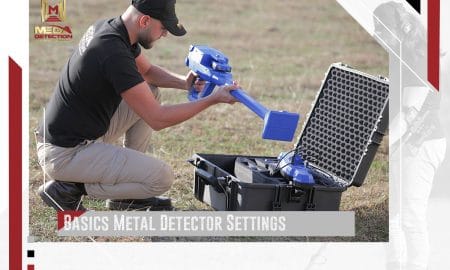Best Detector Setup You Need to Know
Metal Detector Setup , We recommend taking advantage of a couple of Metal Detector Setup for your metal detector. It will, in the long run help you and your mineral prospects. So here are the best all-around metal detector setup you need for your metal detector units.
The performance of your metal detector plays a massive part in the results you’ll be getting. Whether you’re searching for mineral deposits or ancient coins, here are the Metal Detector Setup you need to consider:
1. The metal detector frequencies
2. Sensitivity settings
3. Discrimination settings
4. Ground balance
Metal detectors perform in different capacities, but you can open up a whole window of possibilities by tweaking a couple of the settings offered to you. Not only that, but you may also increase the probability of your finds.
These are but some of the Metal Detector Setup this article will delve into as you keep reading. So get more information on setting up your trusty metal detector.
Metal detector consists of two parts:
A control head with buttons, batteries, knobs, and display.
A coil that creates an electromagnetic field that transmits and receives electrical waves.
Of course, the brains of the detector is located in the control head. “Sensing” the changes in the electromagnetic field is where the different brands use technical magic. Let’s get started on what you need to set up for your metal detector.
Metal detector frequencies
Metal detectors come in numerous formats. One such format that separates them from one another is the frequencies. There are multiple frequencies such as:
- VLF (very low frequency)
- PI (pulse induction)
- ZVT (zero voltage transmission)
- FBS (full band spectrum)
VLF and PI are the most common frequencies found in metal detectors. For those reasons, this article will only focus on VLF and PI. Here’s how they work.
VLF
Experts consider VLF or very low frequency to be pretty old. Why? Because they use magnetic fields. Nevertheless, old is gold, and experts recommend using VLF units when gold prospecting.
How does it work? The control box on the electrical unit generates an electric current. The electric current passes through the coil, and once it leaves the coil, it turns into a magnetic field.
The magnetic field produced by the VLF unit depends on the following factors:
- The size of the coil
- The type of coil
- The frequency
- External factors such as the environment
The magnetic field generated by the coil transmission vibrates at different frequencies. When you discover a metal object, the electrical current flows through the metal object. Now the object will create a magnetic field of its own.
So now you have your VLF unit and an object that have produced two different magnetic waves. Eventually, only the magnetic field from the metal object will remain while the other decays.
In terms of depth, the rule of thumb is that the lower the frequency, the deeper the signal will travel. The downside to this rule is that lower frequencies do not respond to small targets, whereas higher frequencies are more receptive to smaller targets.
PI
The second frequency is PI. PI refers to Pulse Induction. How does it work? PI units send and receive different pulsing frequencies from the ground.
How can you set it up? You can set it up by adjusting the pulse timing and the delay settings. This adjustment will help you determine the depth of your target as well as the sensitivity.
Experts do not recommend PI units if you’re into coin hunting.
They’re an all-rounder type of machine. They cannot discriminate between metals. When do you use PI units?
- They are great for gold prospecting in highly mineralized soils.
- They are also great for beach hunting.
- You can also use them for relic hunting.
2. The Sensitivity Settings on Your Unit
When you buy a metal detector, it will come with a sensitivity feature. This feature allows you to either increase or decrease the sensitivity of your metal detecting unit.
The problem with sensitivity is that it’s one of the most critical features, but users misunderstand its value and functionality. How do they do that? The sensitivity settings allow you to toggle the degree to which your detector signals in response to objects passing through its magnetic field.
If you have a higher sensitivity level on your unit, you’re capable of finding smaller targets or objects. However, if you have a lower sensitivity level, it allows you to pass over unwanted targets.
It is true that the higher the sensitivity, the more the depth. However, the higher the sensitivity, the higher the risk that you will get phantom signals.
So, how do you attain balance? Experts recommend raising the sensitivity level to the point where your unit starts acting erratically. After that, you can slowly lower the sensitivity to an agreeable level.
There is no way to remove phantom or false signals altogether. But dialing it down should reduce the risk of them occurring. It’s getting the best of both worlds. As you get more ad metal detecting, you can slowly start to increase the sensitivity level. It’s a slow and steady process that requires a lot of time and patience.
The Discrimination Settings on Your Unit
Next on this list is the discrimination settings. What is discrimination? Discrimination is the ability of your metal detecting unit to ignore any unwanted signals. At the same time, your metal detecting unit should only allow the targets you want to make a sound.
You get a null sound when you pass over a target metal that you don’t want to hear. That’s the essence of it. The majority of modern metal detectors come with the discrimination feature.
They also come with numerous options you can choose from for this feature like iron, tin, etc. If you come across a metal detecting unit without a discrimination feature, it’s referred to as an all-metal machine.
The downside to this feature is that the more you discriminate, the higher the risk of missing out on valuable targets like gold. Metal detecting units that are beginner-friendly have a discrimination level system.
How does this work? The higher the level of discrimination, the more objects you will block out when prospecting. On the other hand, the more expensive metal detectors come with a notch discriminator.
The notch discriminator allows you to block out specific metals without being limited by a scale. Nevertheless, nothing is perfect, and even notch discriminators aren’t a sound of reason. The best way to find out what you’re prospecting is by digging it up.
Ground Balance
Fourth on this list is ground balancing. What is ground balancing? Ground balancing is a feature that allows your unit to reject naturally occurring minerals in the earth as a target and instead use the earth as a baseline of sorts to find larger or foreign targets.
Currently, the ground balancing feature occurs in two ways:
- Manual ground balancing
- Automatic ground balancing
Furthermore, there’s another occurrence known as ground tracking automatically. You can find this feature on more modern metal detectors, and your metal detecting unit adjusts according to the ground conditions.
Manual Ground Balancing
As the name suggests, it’s a manual process. The user has to adjust the unit as they listen for targets manually. The metal detecting unit relies on you to make the ground balancing. With every change in the environment, the user has to optimize the unit for ground balancing.
How do you change the ground balancing? Well, you can pump your coil up and down every couple of minutes. You can also pump the coil if you notice a change in terrain.
Automatic Ground Balancing and Ground Tracking
The second ground balancing method is the more modern option for metal detectors. The machine will do most of the calibrating as long as the user has done a sequence.
The sequence involves pumping the coil up and down, and the unit will do the rest. Here’s a step by step process:
- Hold the ground balance button while pumping the coil up and down. Ensure to do this on some ground with no metal.
- Stop when prompted by a detector. Some detectors will have two values: the detector’s current ground balance setting and the continuous readout of the ground conditions. When those values drift apart, you perform another ground balance.
The alternative to both of these options is ground tracking. A metal detector with the ground tracking feature will adjust according to the terrain. The downside to this feature is that you can find it with expensive metal detectors.











Leave a Reply